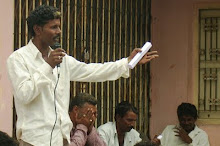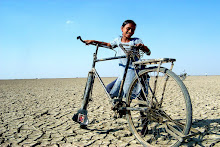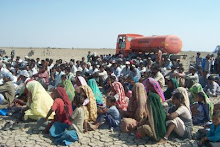The Indian Express: Rajkot: Tuesday, 02 February 2021.
Dozens of workers assembled in the desert at Kharaghoda, the entry point to the LRK near Patdi in Surendranagar district, holding placards announcing their decision to boycott the elections if discharge of Narmada waters was not stopped.
Claiming that Narmada waters discharged into the Little Rann of Kutch (LRK) through rivers had damaged their saltpans in hundreds of hectares, a group of agariyas (saltpan workers) staged a demonstration at Kharaghoda and threatened to boycott the upcoming local body elections if the discharge of freshwater was not stopped.
Dozens of workers assembled in the desert at Kharaghoda, the entry point to the LRK near Patdi in Surendranagar district, holding placards announcing their decision to boycott the elections if discharge of Narmada waters was not stopped.
“I have been doing pata (cultivating salt on a stretch of land) for years but water is washing away my embankments. I am halfway through the salt-cultivation season and if the water discharge is not stopped, I will lose all my production. I plead government and officers of Narmada to listen to us,” said Gunvant Thakor, one of the agariyas cultivating salt in Kuda desert area in LRK.
Thakor said that around 5,000 agariyas were affected by flooding in the LRK and were facing the prospect of “no harvest of salt”.
Harinesh Pandya, president of Agariya Hit Rakshak Manch (AHRM), an NGO working for the welfare of agariyas, said that around 140 patas or clusters of saltpans were damaged by flooding.
“The agariyas start working on their field in November and salt becomes ready for harvest by March-April. However, around 140 patas in the 70 km long and four km wide stretch from Patdi to Halvad on the border of Wild Ass Sanctuary have been damaged due to flooding… over the past two months. Each agariya stand to lose salt worth around Rs 7 to Rs 8 lakh,” Pandya said.
LRK, a 440-square kilometre expanse of mudflats gets inundated during monsoon as rivers such as Banas, Luni, Khari, Rupen of north Gujarat and Brahmani of Saurashtra drain into the desert. But the floodwaters generally clear by the onset of winter, making the desert land available for salt cultivation.
“But over the past decade, unseasonal flooding has been witnessed in the desert every alternate year due to mismanagement of Sardar Sarovar Narmada Nigam Limited (SSNNL). Following demand by farmers, the SSNNL releases water into its canal network and rivers but many a time, the discharge volume is much more than what the farmers require… Due to this, agariyas are losing their livelihood and lakhs of gallons of fresh water goes waste,” Pandya added.
Rajiv Kumar Gupta, managing director of SSNNL, said that Vivek Kapadia, director of SSNNL, who had done a lot of work in this should be contacted.
Kapadia said the SSNNL was cognisant of the matter but claimed that discharge from Narmada canal network was not the only reason. “We had released some water in Rupen from Narmada main canal following demand from farmers… This can be one of the contributing factors to the flooding. But monsoon was very good in north Gujarat this year and there is sub-surface flow from rivers such as Luni, Banas, Khari, Rupen, etc. There are other drains also. All this might be causing flooding. But we acknowledge the issue and are looking ways to address it,” he said.
Claiming that salt cultivation in LRK is unconventional, Kapadia added, “Unlike the conventional method of channeling seawater into saltpans, agariyas here exploit brakish groundwater… there are other issues as well and require a multi-department response. We are working on this.”
Dozens of workers assembled in the desert at Kharaghoda, the entry point to the LRK near Patdi in Surendranagar district, holding placards announcing their decision to boycott the elections if discharge of Narmada waters was not stopped.
Claiming that Narmada waters discharged into the Little Rann of Kutch (LRK) through rivers had damaged their saltpans in hundreds of hectares, a group of agariyas (saltpan workers) staged a demonstration at Kharaghoda and threatened to boycott the upcoming local body elections if the discharge of freshwater was not stopped.
Dozens of workers assembled in the desert at Kharaghoda, the entry point to the LRK near Patdi in Surendranagar district, holding placards announcing their decision to boycott the elections if discharge of Narmada waters was not stopped.
“I have been doing pata (cultivating salt on a stretch of land) for years but water is washing away my embankments. I am halfway through the salt-cultivation season and if the water discharge is not stopped, I will lose all my production. I plead government and officers of Narmada to listen to us,” said Gunvant Thakor, one of the agariyas cultivating salt in Kuda desert area in LRK.
Thakor said that around 5,000 agariyas were affected by flooding in the LRK and were facing the prospect of “no harvest of salt”.
Harinesh Pandya, president of Agariya Hit Rakshak Manch (AHRM), an NGO working for the welfare of agariyas, said that around 140 patas or clusters of saltpans were damaged by flooding.
“The agariyas start working on their field in November and salt becomes ready for harvest by March-April. However, around 140 patas in the 70 km long and four km wide stretch from Patdi to Halvad on the border of Wild Ass Sanctuary have been damaged due to flooding… over the past two months. Each agariya stand to lose salt worth around Rs 7 to Rs 8 lakh,” Pandya said.
LRK, a 440-square kilometre expanse of mudflats gets inundated during monsoon as rivers such as Banas, Luni, Khari, Rupen of north Gujarat and Brahmani of Saurashtra drain into the desert. But the floodwaters generally clear by the onset of winter, making the desert land available for salt cultivation.
“But over the past decade, unseasonal flooding has been witnessed in the desert every alternate year due to mismanagement of Sardar Sarovar Narmada Nigam Limited (SSNNL). Following demand by farmers, the SSNNL releases water into its canal network and rivers but many a time, the discharge volume is much more than what the farmers require… Due to this, agariyas are losing their livelihood and lakhs of gallons of fresh water goes waste,” Pandya added.
Rajiv Kumar Gupta, managing director of SSNNL, said that Vivek Kapadia, director of SSNNL, who had done a lot of work in this should be contacted.
Kapadia said the SSNNL was cognisant of the matter but claimed that discharge from Narmada canal network was not the only reason. “We had released some water in Rupen from Narmada main canal following demand from farmers… This can be one of the contributing factors to the flooding. But monsoon was very good in north Gujarat this year and there is sub-surface flow from rivers such as Luni, Banas, Khari, Rupen, etc. There are other drains also. All this might be causing flooding. But we acknowledge the issue and are looking ways to address it,” he said.
Claiming that salt cultivation in LRK is unconventional, Kapadia added, “Unlike the conventional method of channeling seawater into saltpans, agariyas here exploit brakish groundwater… there are other issues as well and require a multi-department response. We are working on this.”
















.jpg)
.jpg)
.jpg)
.jpg)













No comments:
Post a Comment